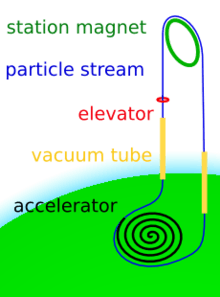Space fountain
A space fountain is a proposed form of an extremely tall tower extending into space. As known materials cannot support a static tower with this height a space fountain has to be an active structure: A stream of pellets is accelerated upwards at a ground station. At the top it is deflected downwards. The necessary force for this deflection supports the station at the top and payloads going up the structure.[1] Spacecraft could launch from the top without having to deal with the atmosphere. This could reduce the cost of placing payloads into orbit. As downside the tower will collapse if the containment systems fail and the stream is broken. This risk could be reduced by several redundant streams.[2]

The lower part of the pellet stream has to be in a vacuum tube to avoid excessive drag in the atmosphere. Similar to the top station this tube can be supported by transferring energy from the upwards going stream (slowing it) to the downwards going stream (accelerating it).[3]
Unlike a space elevator this concept does not need extremely strong materials anywhere and unlike space elevators and orbital rings it does not need a 40,000-kilometre (25,000 mi) long structure.[3] One downside of the space fountain is that it does not provide orbital speed on its own; payloads released from the top have zero velocity relative to the ground.
See also
References
- Paul Lucas (14 July 2003). "Orbital Railroads: Beanstalks and Space Fountains". Retrieved 14 December 2018.
- Gregory Feeley (March 1992). "Stairways to Heaven". Retrieved 14 December 2018.
- Forward, Robert L. (1995), "Beanstalks", Indistinguishable From Magic, p. 79, ISBN 0-671-87686-4